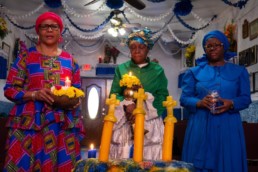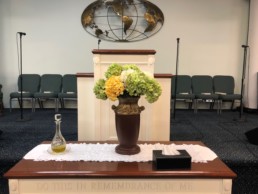The Opening of Service
The Opening of Service
Esohe Osabuohien | eco2132@columbia.edu
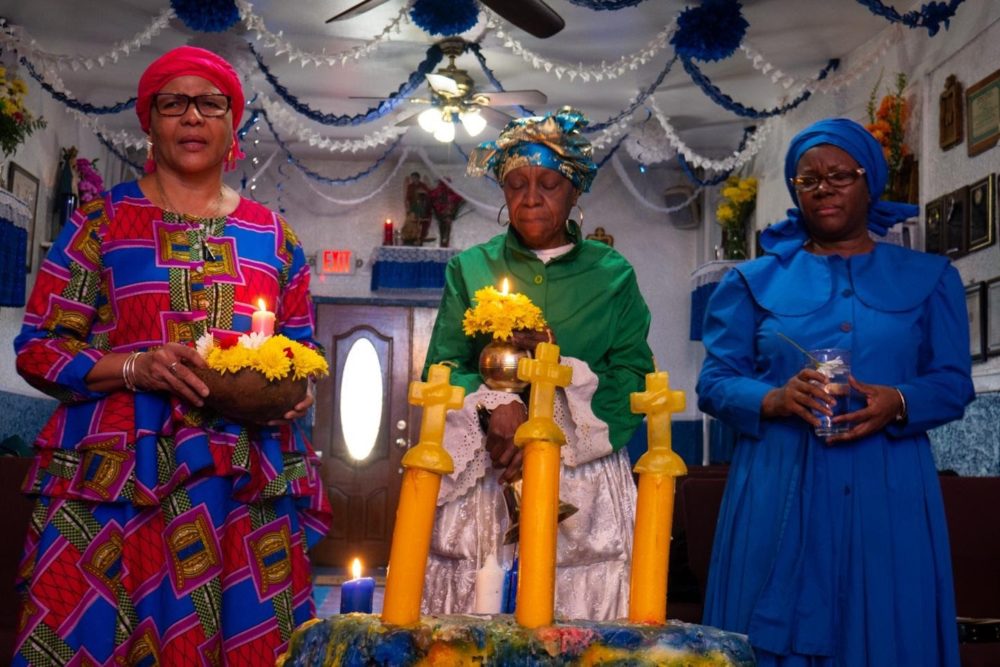
The parishioners at the Yoruba Orisha Baptist Church in Brooklyn are adorned in white and multicolored headwraps, as well as dresses traditional to Trinidad and Tobago, the country from which most of the members immigrated.
The white headwraps have a dual purpose, said a longtime member known simply as Mother Cora, an older woman who has been with the church since its earlier days.
“It is to signify that today is Holy Communion, and also how we know who’s a visitor as they would not know ‘white’ is the customary uniform for today,” she explains with a smile.
As other members file in on a recent Sunday, they are greeted by the newly decorated vestibule that is covered in Christmas lights, blue and white streamers, and a banner that reads: “Happy Anniversary,” in preparation for the church’s anniversary and celebration of Our Lady of Lourdes Day. They are also greeted by the Rev. Selwyn Wilkinson, the spiritual father of the Yoruba Orisha Baptist Church, who founded the church in 1998 upon immigrating to New York City from Trinidad and Tobago.
The Yoruba Orisha Baptist Church, located on 2089 Nostrand Avenue in Flatbush, is primarily made up of people from the Caribbean who brought with them to Brooklyn elements of Spiritual Baptist tradition, Trinidad Orisha practice and other forms of ancestral worship. These traditions mirror the customs of [Cuban] Santeria in that they are rooted in the Yoruba religion - an African ancestral faith - that was brought to the Americas and Caribbean during the transatlantic slave trade and syncretized with Christianity.
After the members take their places, the women elders, known as “mothers,” are positioned at the front of the church sitting along the side of the ornately decorated altar that is adorned with candles, a Black Jesus Christ, a photo of former President Barack Obama, flowers, and a bell. As the mothers continue lighting candles in the vestibule, everyone quiets signifying that service is about to begin.
“If you’re going to go out the night before, then we must still remember that church service begins at 11 a.m., sharp. Church elders should be here by 10:30 a.m” said Wilkinson sternly.
The church’s phone line states that service starts promptly at 11 a.m., but when the majority of the members arrive and set up, it is a quarter to noon.
Before the service can fully start, the mothers of the church instruct the congregation to form a circle around a rainbow-colored pillar of wax known as the Steps of Calvary. At the top of the steps sit three yellow candles in the shape of crosses, representing Jesus Christ and the two thieves on Mount Calvary. Below the top step, are candles of various colors and sizes, a pink candle is also lit and a bowl filled with water and a single white carnation is placed at the base of the pillar alongside a silver anchor and gold handbell. Next, one of the mothers walks around the circle pouring Florida Water cologne onto our hands. The room is instantly filled with the Water’s light citrus scent mixing with the heavy smoke from the candles creating a sweet fragrance in the space.
The Holy Spirit
The Holy Spirit
Zoé Chevalier | zc2504@columbia.edu
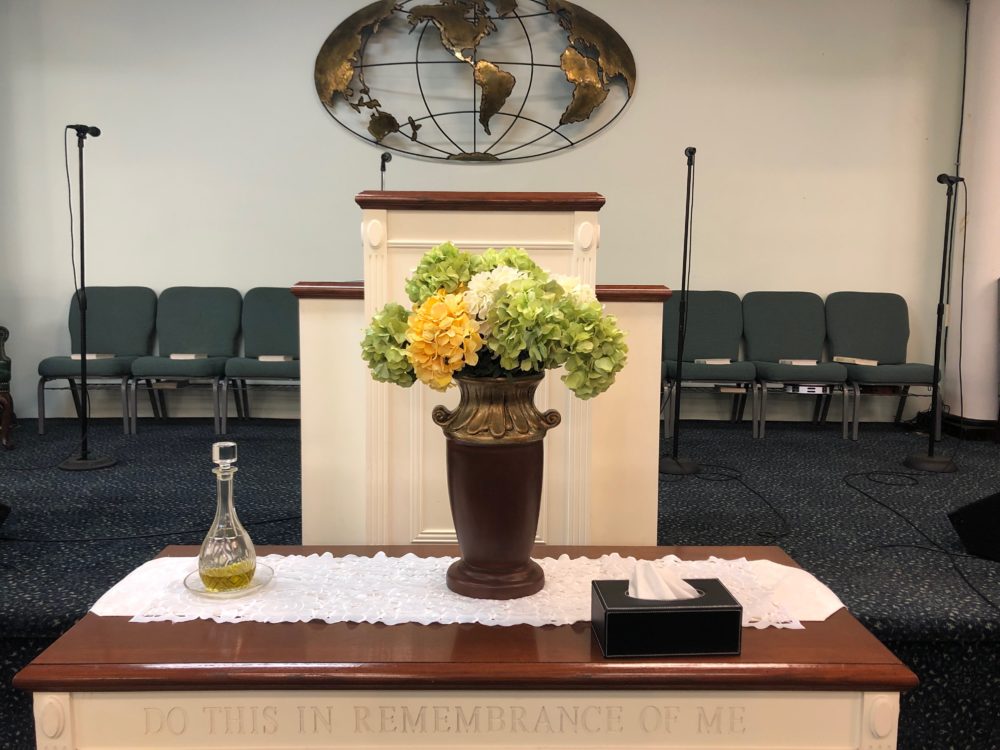
The congregation slowly gathers inside the prayer hall at the United Pentecostal Church on 125th Street, between Broadway and Amsterdam. Sunday school ran a little late, but that’s ok, there are no formal hours here. The prayer service will last for about two and a half hours, but none of it will be passive: Worshippers will stand, move, dance, and sing.
Rows of chairs face a stage, where microphones and instruments—an electric piano, drums and a tambourine—signal the singing to come. No crosses, stain-glass windows or icons of saints can be seen here. Although Pentecostals believe in Christ, the traditional crucifix found in Catholic churches is replaced with a large statue representing the earth and a collection of flags from different countries. In front of the pastors console is a wide communion table, covered by a white veil. “It’s to make it look religious,” says Pastor Michael Grattan.
Patrice Martin has come all the way by bus from Philadelphia to be here today. Grattan witnessed to her 40 years ago, when she was a college student. “He saved me,” says Martin. But she feels directionless, and came to the Church to reconnect with the one who once helped her. Martin does not want to bother him, and so she sits in a corner. When the pastor comes to say hi, she introduces herself as Sister Patrice Martin. He thinks about it and says, “That’s strange. I witnessed to a Sister Patrice many years ago.” They fall into each other’s arms.
One of the singers, dressed in all white comes up to the audience, arms opened. “Let’s have a group hug,” she says. Slowly, she walks away into a corner of the room, where worshippers gather. A circle is formed. At first quiet, the circle soon comes to life. The Holy Spirit is about to arrive. Worshippers are moving their hips and raising their hands, opening their mouths wide. The rumble of their feet on the ground creates vibrations, which are growing throughout the church.
A symphony of different languages is spoken all at once: English, French, Spanish and many other languages that I do not recognize. Most of it is unintelligible, with a repetition of “Amen” and “Hallelujah,” creating a rhythm, and growing faster, louder, more passionate.
Another singer is brought into the middle of the circle. Surrounded by her peers, she bangs her chest right above her heart and moves her hands to the rhythm of her words. They are praying for her. Some are smiling, looking up at the heavens, at times letting out a powerful laugh.
Others give out painful moans, bow their heads.
Brother Philippe comes up to me and explains in French. “They are letting the Holy Spirit speak through them. They just open their mouths and let him speak.” Like many people here, Philippe was once a Catholic, but he grew tired of needing intermediaries to speak with God. Pentecostals do not believe in the Virgin Mary as the first interlocutor. “It’s like parents with their children,” explains Philippe. “You do not need to have your mother always intervene on behalf of you to your father, you have to go directly.”
Pentecostals believe in a direct approach to the Lord. No Saints, no Virgin Mary is needed as intermediary. Once a person has been “saved,” the previous “sinner” becomes a saint. All baptized members of the church are saints. They can speak directly to God, and let the Holy Spirit speak through them. They are also called to “witness” to other “sinners,” and transmit the word of the Lord.
This ritual is rooted in the day of the Pentecost, a passage in the Bible’s Book of Acts, the fifth book in the New Testament. According to Acts 2:4, the Holy Spirit descended upon Jesus’ apostles, baptizing them in the Holy Spirit, “and there appeared unto them cloven tongues like as of fire, and it sat upon each of them. And they were all filled with the Holy Ghost, and began to speak with other tongues, as the Spirit gave them utterance.” Pentecostals believe in a literal interpretation of the Bible, and see speaking in tongues as an act that can happen at any time, to anyone who has been saved.
This speaking in tongues continues throughout the service. Sometimes, as Grattan is preaching, someone will start laughing uncontrollably, someone else will speak in a different language. Once some people started making snake-like noises in the back of the room, the hissing sounds growing louder. When the Holy Spirit wants to speak, you let him in. As the service progressed, Grattan’s sermon grows more passionate:
“Don’t waste your alone time and your suffering, praise the Lord and nothing should offend you. If you can’t run, walk, and if you can’t walk, roll, but keep following God. We are the chosen people, the Second Testament says so! We are like the Jews.”
Suddenly, he stops, and the voices in the crowd go silent. One by one, some worshippers go up in front of the stage and kneel in front of the pastor, waiting to be blessed. A pregnant woman bows with difficulty. Children run up to the stage.
The adults wait patiently as Grattan slowly kneels to their level, holds their head and whispers “In the name of Jesus Christ.” Slowly they go back to their seats, calmer, blessed. Sister Patrice stayed in her seat the whole time, her eyes closed, praying. At times, she called out “Amen, Halleluyah.” A glorious smile was spread across her face.
A Symbol of Sikh Identity
A Symbol of Sikh Identity
Meenketan Jha | mj2930@columbia.edu
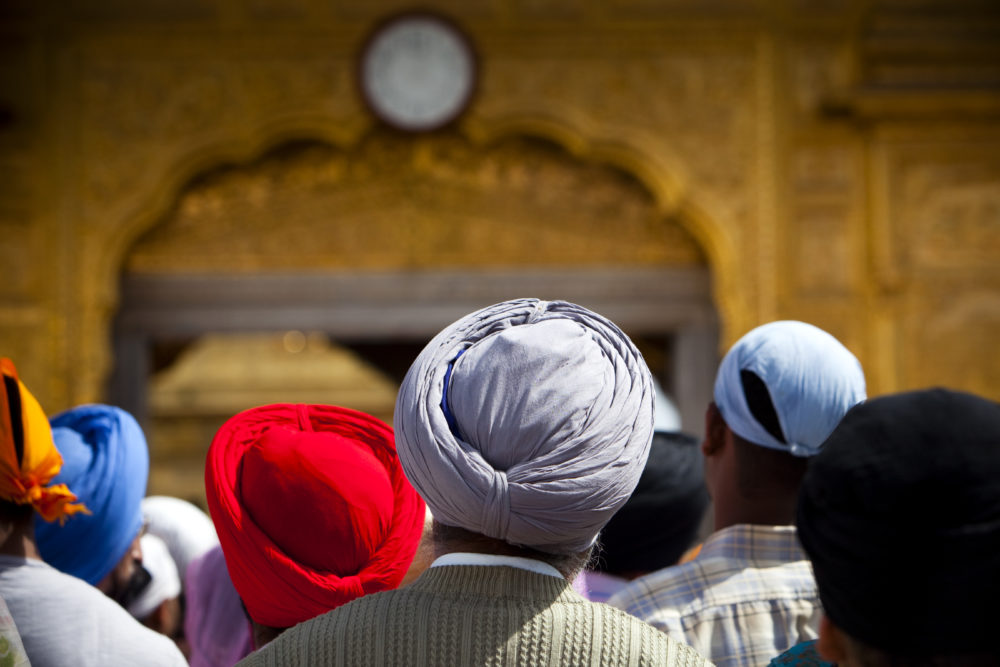
I stood there stranded, clueless as to where to go. On either side of me, a crowd of men and women rushed past to take their place. I was visiting a Sikh temple in Queens, a house of worship as a Gurudwara. Right in front of me was the Guru Granth Sahib, the central religious scripture in Sikhism. I peered around to pick the best location to sit. Hair uncovered I was sticking out like a blue bowl sitting in a cupboard full red dinnerware. Aside from my phone buzzing at maximum volume, the space was filled only with the subtle noise of the hymns of kirtan.
Men and women sat separately on either side of the room; even the young children were separated by gender. While the gender split is a common part of religions originating from the Asian subcontinent, a lot of such unsaid rules are rarely a part of modern-day practices. Although this isn’t an obligation, Sikhism is one of the few faiths where original gurus teach on equality between the sexes giving women equal rights in all spheres of the belief. One can view the segregation as a sign of balance between the two sexes – not one needing to be dependent on the other.
All those gathered at the Temple, on Broadway and 61st in Flushing, Queens, regardless of gender, had covered their hair. Men wore the Sikh turban and women used their shawls to cover their hair. The turban has always been an essential part of daily attire for a Sikh male. The head of the Gurudwara, Brahm Das ji, wore the look of horror as he scurried towards me.
“Cover your hair, son!” he said as he pulled me to the outside of the hall handing me over a handkerchief with a picture of the khanda, a symbol of Sikhism, adorned on it. “Have you never been to a Gurudwara before?”
Although I lived most of my life in India, I had never been to a Gurudwara before. In a Hindu temple, which I frequent, men do not have to cover their heads though the same rule doesn’t apply for women.
I scampered to cover my hair. Those who did not have a turban took handkerchiefs from around their heads, before giving me an odd look as I struggled with mine. Seeing my fruitless attempt, Amitoj Singh, a man in his early 30s came to help me.
“Your first-time son?” he asked. I nodded asking him why it was imperative that I cover my hair. “It’s maryada (modesty),” he replies. “An act of benevolence towards the Higher Being who dictates my life and makes miracle happen every day, I am bowing to the almighty in thanks and gratitude.”
One of the world’s newer religions, Sikhism derives its principles from faiths all over while adding a few uncompromising components like cleanliness. Unlike other religions, Sikhism’s core values call for cleanliness, respect, valor, perseverance, and equality. The turban houses and protects uncut hair, a sacred custom for those who follow the faith, the hair is tied up to the important spiritual center of your body – the Dasam Duar (7th Chakra). Crossing the pressure points on our temples, the turban helps an individual keep calm and reserved in times of turmoil and prayer.
“Nowhere in the Guru Granth Sahib does it say you have to wear a turban, but we do it. Why? Because the turban is a symbol of pride, valor, and distinction (naira), the last of the Sikh gurus is said to have his blessings on all those who stay naira,” says Brahm Das Ji in a conversation with me once the ceremony is over.
Brahm Das adds that because the turban makes Sikhs stand out, it also makes them accountable for their actions. The faith says that everybody is equal in God’s eyes and sex does not hinder your relationship with God. It also disregards, in theory at least, Hinduism’s rigid, structural caste system where people are subjected to a position on four-tier based social strata.
Silent Tears
Silent Tears
Annick Laurent | acl2220@columbia.edu
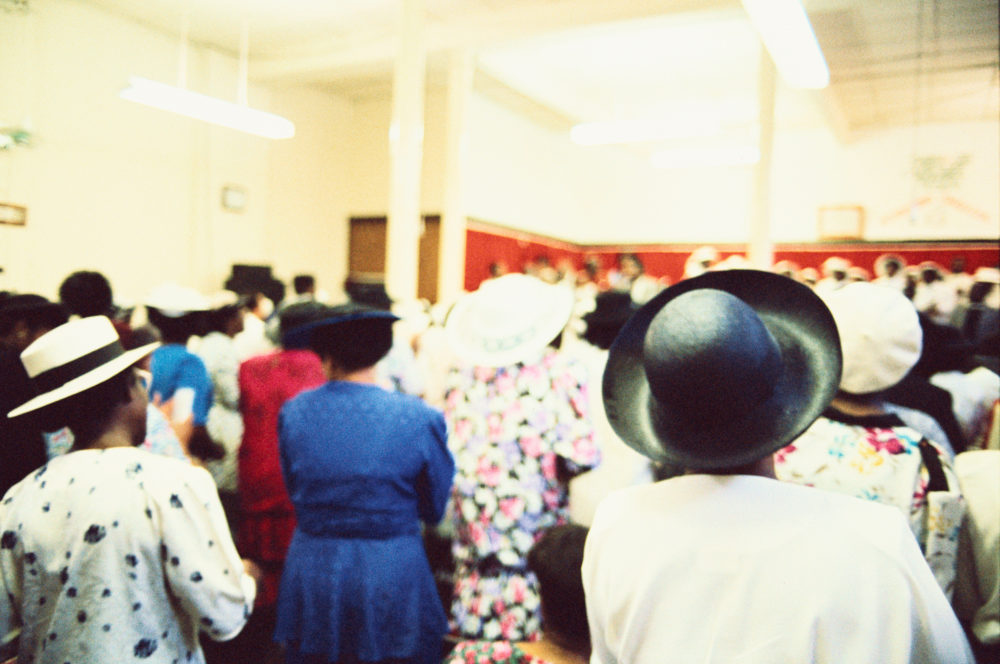
On a recent Sunday morning, the Sanctuary Choir at the Convent Avenue Baptist Church in Harlem sits relatively still, with the exception of those fanning themselves with the day’s programs. There are about 40 choir members, all dressed in bright blue robes with kente cloth embellishments sewn on the shoulders.
On the church floor, white-gloved ushers are guiding late comers across the wine-colored carpet to the few remaining spots in the roughly 1,000-seat church. Above the choir is an arch with the phrase “One Lord, One Faith, One Baptism,” painted on it in all caps.
Seconds later, Dr. Gregory Hopkins, the choir’s director, gives the singers the cue to rise to their feet. A familiar melody fiercely erupts from the organ. It is “Lift Every Voice and Sing” and it is sung by the choir with palpable pride to commemorate Black History Month and honor the souls of ancestors who fought for freedom.
The instrumental version of the first line plays once:
“Lift every voice and singgggg...”
Ed Broms, the organist, held on the note for “sing” in the opening line with a key on his left hand as his other one fluidly moves through the right side with ease. Light flute-like notes flutter in the air with quick succession, layered the deep “sing.”
Broms repeats the opening phrase a few more times, going higher on the scale with smooth transitions.
With the grace of a dancer, Hopkins raised his arms with pulsing wing-like motions to the beat of the spiritual. The choir followed his pace.
The first stanza is delivered in staccato fashion:
“Lift every voice and sing
Till earth and heaven ring
Ring with the harmonies of Liberty
Let our rejoicing rise
High as the list'ning skies, let it resound, loud as the rolling sea.”
The tenors and sopranos distinguish themselves in tone and delivery. The women repeat “lift every voice and sing” at the end of each line
“Sing a song full of faith that the dark past has taught us
Sing a song full of the hope that the present has brought us
Facing the rising sun of our new day begun
Let us march on, let us march on, ‘til victory is won”
Originally conceived in 1900 as a poem, “Lift Every Voice and Sing” was penned by James Weldon Johnson, who was a lawyer and high school principal before pursuing a writing career full-time. J. Rosamond Johnson added the music to the ballad five years later, giving its poignant lyrics a vivacious uplifting accompaniment. Their collaboration is often regarded by African Americans as the “Black National Anthem” in addition to being a hymn that calls on God for aid through strife and fatigue.
I am overwhelmed hearing it sung. The choir’s rendition takes me on a winding emotional rollercoaster. The preface is buoyant and encouraging in the first verse before it transforms into something reminiscent of a chant for steadily marching soldiers. It is a musical salute to the foreparents, acknowledgement of sacrifices along a rocky unrelenting treadmill of a path.
Greatly contrasting the thundering start, the next verse is a whisper by comparison.
We have come, we have come over a way
That with tears have been watered
We have come, we have come treading our path
Through the blood of the slaughtered,
Out from the gloomy past,
Where the white gleam of our bright star is cast.
“The slaughtered.” Unfallen tears put pressure on my eyes.
The notes become less divergent, almost meeting in the middle. The tune slows and takes a somber turn, embodying communal mourning.
God of our weary years,
God of our silent tears,
Thou who has by Thy might
Led us into the light,
Keep us forever in the path, we pray.
Lest our feet stray from the places,
Our God, where we met Thee,
Lest, our hearts drunk with the wine
Of the world, we forget Thee;
Shadowed beneath Thy hand,
May we forever stand.
True to our GOD,
True to our native land.”
The choir ended the song in a rich, dragging, reverberating “Amennnn.”
The Invitation
The Invitation
Kate Cammell | kac2261@columbia.edu

With her right hand placed over her heart and her left palm opened towards the balcony, Angela Lockett-Colas invited everyone in the church to join in the communion service. The stage lights above her shifted from ice blue to light pink and the eight-member praise band began to play a soft rock melody.
Forefront is an interdenominational church with roots in the Evangelical movement. It’s tucked along a Borem-Hill side street at 509 Atlantic Avenue. During a Sunday morning service, Lockett-Colas, Forefront’s creative director, told the congregation, “Communion is something we do because of the gift we have in Jesus Christ.” As the beat picked up tempo, she reminded the nearly 150 gathered people of the ways that Jesus suffered. “You might feel [persecuted] like that too but you’re loved. You’re loved,” she said.
As Lockett-Colas ushered congregants into the ritual, there was a fullness to her tone that felt assuring, like a mother comforting her children. She beamed as she summoned “anyone” to receive God’s love and to affirm their commitment to Him.
People stood below her on either side of the stage with wooden bowls of bread and large mason jars of red wine, symbolizing the body and blood of Christ. In the Protestant expression of Christianity, communion is a ritual where believers dip bread in wine, and as they eat the mixture they’re asked to reflect on Jesus’ sacrifice.
After Lockett-Cola spoke, members were initially slow to take communion. It was early, so people puttered, like the city buses that had ushered some there that morning. In the last row of the chapel, Georgina Orin followed her friend Grace Dowd into the aisle. Orin’s polka dotted dress sashayed on the wooden floor as she moved in time to the music. Orin, a Californian who once lived in New York, attends Forefront whenever she’s in town.
For Orin, communion is about taking a moment to think about herself in relation to the world around her. Despite the music and the whirl of the lights, there’s a stillness that believers talk about inside themselves. “I think communion is a way to remind you to nourish yourself and that you’re a part of something bigger,” she said.
After reaching the front of the line and dipping the bread in wine, Orin and Dowd made their way back down the aisle. Back at their seats, Orin rested her head on Dowd’s shoulder as they listened to the praise band. People around them raised their hands in the air and bounced on their heels, feeling the music and waiting for everyone to partake in the weekly rite.
Just in case anyone missed Lockett-Colas’s invitation, it was underscored by bold white letters on a large screen at the front of the chapel. “Communion,” the sign announced. Below that it read: “All are welcome at God’s table.” And for Forefront’s members who, like Dowd, identify as queer, seeing “all” written onscreen was key. It’s why many choose to take communion here.
Forefront became an LGBTQ-affirming church in 2014, a controversial move for an Evangelical congregation. The choice was met with loss of both members and funding, but the church stood by its choice. It’s website proudly reads, “We seek community that is inclusive of ALL people.”
Though communion is an individual practice, it’s undertaken—as its name implies—as a community. At Forefront that includes “Conventional Christians and questioning skeptics, Believers and agnostics, Women and men, those of all sexual orientations and gender identities, and Those of all classes and abilities.” It’s a church where juxtapositions are encouraged to rub shoulders.
This is reflected in the communion service as well—old tradition meets new meaning, and, for those who partake of it, a fortification with the warmth of red wine and dance on a chilly February morning in New York City.

